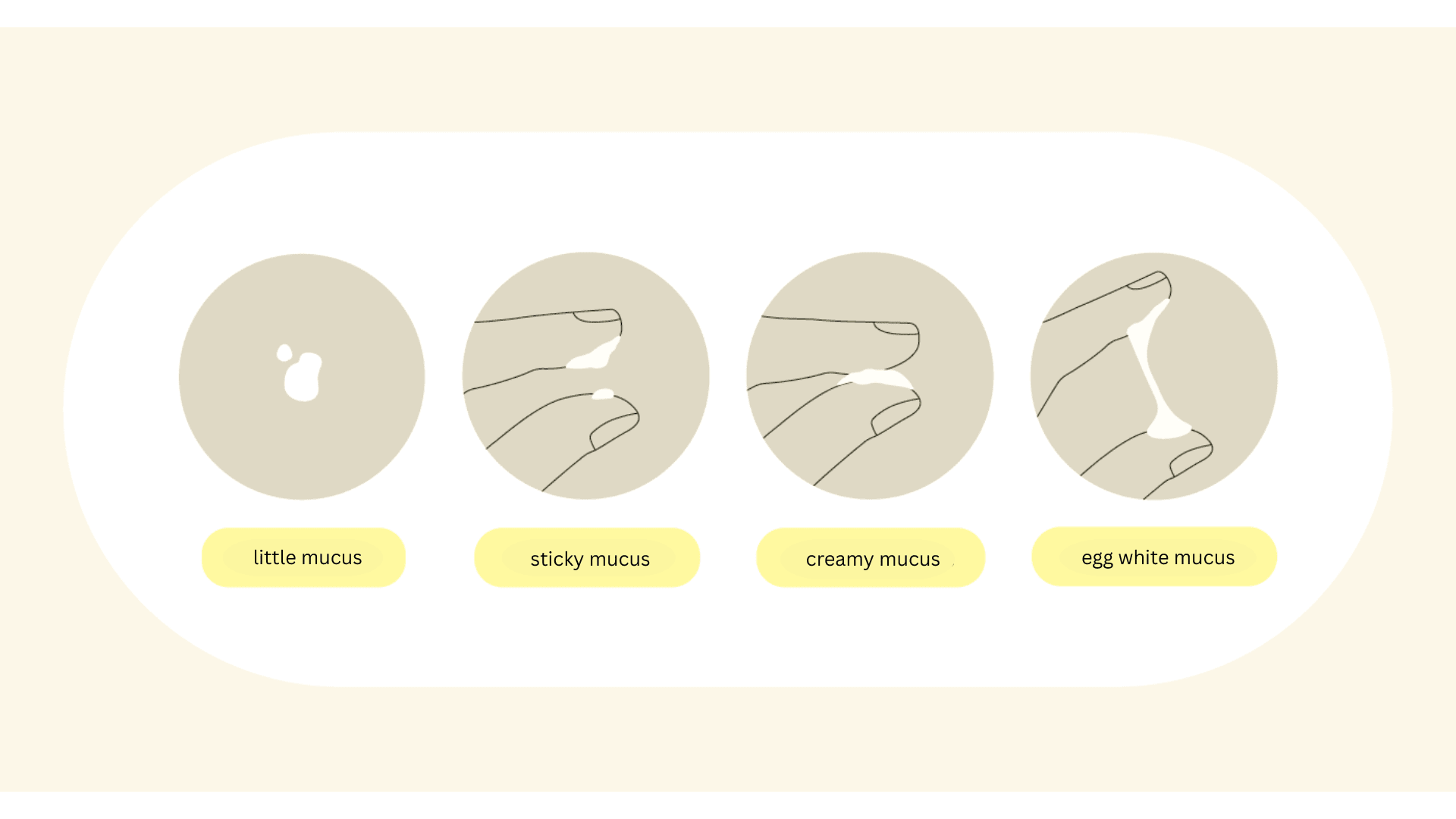By paying attention to cervical mucus , you can better understand your menstrual cycle, identify the signs of ovulation, and increase your chances of getting pregnant.
Key Facts About Cervical Mucus Around Ovulation
- Cervical mucus changes throughout the menstrual cycle due to hormonal fluctuations
- Around ovulation, it becomes clear, stretchy, and similar to raw egg white
- Cervical mucus is an indicator of fertility but not a reliable birth control method
- Its main function is to protect sperm during fertile days and help them move toward the egg
- The quality of cervical mucus can be influenced by stress, medication, and smoking
How Does Cervical Mucus Change During Ovulation?
Cervical mucus plays a central role in the female reproductive cycle and provides important clues about your fertile window. If you want to track ovulation more effectively or improve your chances of pregnancy, observing cervical mucus is one of the best natural fertility awareness methods.
This guide explains how cervical mucus changes before, during, and after ovulation — and how you can use these changes for natural family planning.
What Is Cervical Mucus?
Cervical mucus is produced by the glands of the cervix. Its primary purpose is to support sperm on their journey to the egg. The texture and consistency of cervical mucus change throughout the menstrual cycle, controlled by the hormones estrogen and progesterone.
What Does Cervical Mucus Look Like During Ovulation?
In the days leading up to ovulation, you may notice that cervical mucus becomes more abundant and changes texture. Right before ovulation, cervical mucus becomes clear, slippery, stretchy, and looks very similar to raw egg white. You can test this by stretching it between your thumb and index finger. Egg white cervical mucus is one of the most reliable signs of ovulation and indicates your most fertile days.
In this podcast, you’ll learn what cervical mucus reveals about your fertility.
Why Does Cervical Mucus Change Around Ovulation?
After ovulation, the corpus luteum forms in the ovary from the follicle that released the egg. This structure produces more progesterone. However, an egg cell can only be fertilized for about 12 to 24 hours. Identifying this exact window by cervical mucus alone is difficult.
Fortunately, sperm can survive in the female reproductive tract for up to five days. That means if you have regular unprotected sex during your fertile days, sperm may already be present in the uterus or fallopian tubes when ovulation occurs. This also explains why cervical mucus observation is not a reliable contraceptive method. It can help identify fertile days, but it’s not secure enough for birth control.
Recent research also points to the biochemical complexity of cervical mucus. A proteomic study identified 25 proteins that change cyclically, suggesting that in the future, laboratory-based or even at-home tests could use these molecular markers to predict ovulation more precisely.
Cervical Mucus Changes Throughout the Menstrual Cycle
Shifts in estrogen levels cause cervical mucus to appear differently at various stages of the cycle. Both the amount and texture change depending on your hormonal balance.

After your period, there is usually very little or no mucus, and the vagina may feel dry. Estrogen levels are low at this time, which means sperm cannot survive or move easily, and this phase is typically considered infertile. As estrogen rises in the days before ovulation, cervical mucus becomes creamier, whitish, and thicker in consistency, often visible at the vaginal opening.
At the peak of fertility — just before and during ovulation — cervical mucus becomes clear, slippery, stretchy, and elastic like raw egg white. This egg white cervical mucus creates the perfect environment for sperm to survive and fertilize the egg.
After ovulation, cervical mucus changes again. It becomes thicker, creamier, and cloudy, and the amount decreases. At the same time, the cervix lowers and hardens, forming a kind of barrier that helps protect the uterus from bacteria.
These cyclical changes in cervical mucus are not random. They are designed to support conception, optimize sperm survival, and prepare the uterus for possible implantation.
Here you'll get a full explanation about cervical mucus changes during your cycle:
How to Check Cervical Mucus
Cervical mucus can usually be observed during daily activities, especially when using the bathroom. Ways to check include: examining mucus on toilet paper after wiping, collecting a small sample at the vaginal entrance with clean fingers (after washing hands with soap and warm water for at least 20 seconds), or observing discharge in your underwear. By regularly checking, you can learn to recognize the different consistencies that signal fertile and infertile phases.
How to Improve Cervical Mucus Quality
A healthy lifestyle supports fertile cervical mucus. Eating a balanced diet rich in fruits, vegetables, legumes, and whole grains, along with drinking two to three liters of fluids per day, creates the best foundation for healthy mucus production. Some people claim that grapefruit juice or green tea can improve cervical mucus quality, but these effects are not scientifically proven.
Takeaway
Cervical mucus changes throughout the menstrual cycle depending on hormone levels. Shortly after menstruation, cervical mucus is often barely noticeable or the vagina feels dry. As estrogen levels rise, discharge becomes creamier and then more fluid. At ovulation, cervical mucus reaches its peak and resembles raw egg white — this is the most fertile time, when chances of conception are highest. After ovulation, cervical mucus becomes thicker, cloudy, and less abundant, signaling lower fertility.
For couples trying to conceive, the most favorable time for intercourse is in the days leading up to ovulation and on ovulation day itself. While it takes practice to become familiar with cervical mucus patterns, once you can interpret the signs, cervical mucus becomes an invaluable tool for natural fertility awareness and cycle tracking.
Frequently Asked Questions on Cervical Mucus
How long are you fertile after cervical mucus peak?
The fertile window usually lasts about six days. It begins around five days before ovulation and ends on the day of ovulation. The cervical mucus peak typically occurs one to two days before ovulation, which means you are still fertile for about one to two days afterward.
What is the difference between cervical mucus and ovulation?
Cervical mucus should not be confused with vaginal discharge, which is a general term for secretions and can sometimes indicate infection, or with leukorrhea, a thin whitish discharge that is common during pregnancy. The vaginal microbiome is dominated by Lactobacillus bacteria, which produce lactic acid and create an acidic environment that protects against infections. Vaginal discharge throughout the cycle can be seen as a natural cleansing mechanism, but during fertile days its role is to support sperm survival and movement.
How do I use cervical mucus for Natural Family Planning (NFP)?
With NFP, you record daily whether cervical mucus is present and note its consistency. You also measure your basal body temperature every morning before getting out of bed and enter the results into an app or cycle chart. A temperature rise indicates that ovulation is imminent. You can also use an ovulation calculator or check the cervix position to confirm fertile days. Other methods include the Billings method, which relies solely on cervical mucus observation, and the symptothermal method, which combines basal temperature with cervical mucus or cervix position.
Is arousal fluid the same as cervical mucus?
No. Cervical mucus is produced in the cervix and indicates fertility, while arousal fluid is produced by the Bartholin’s glands during sexual arousal. Arousal fluid acts as a natural lubricant but is not related to ovulation or fertility tracking.
Does cough syrup improve cervical mucus?
Some cough syrups contain guaifenesin, an expectorant that thins mucus in the airways. This effect can sometimes make cervical mucus thinner and more permeable to sperm. However, the effect is not strong enough to significantly improve fertility, and there is no scientific evidence supporting the use of cough syrup to enhance conception chances.







